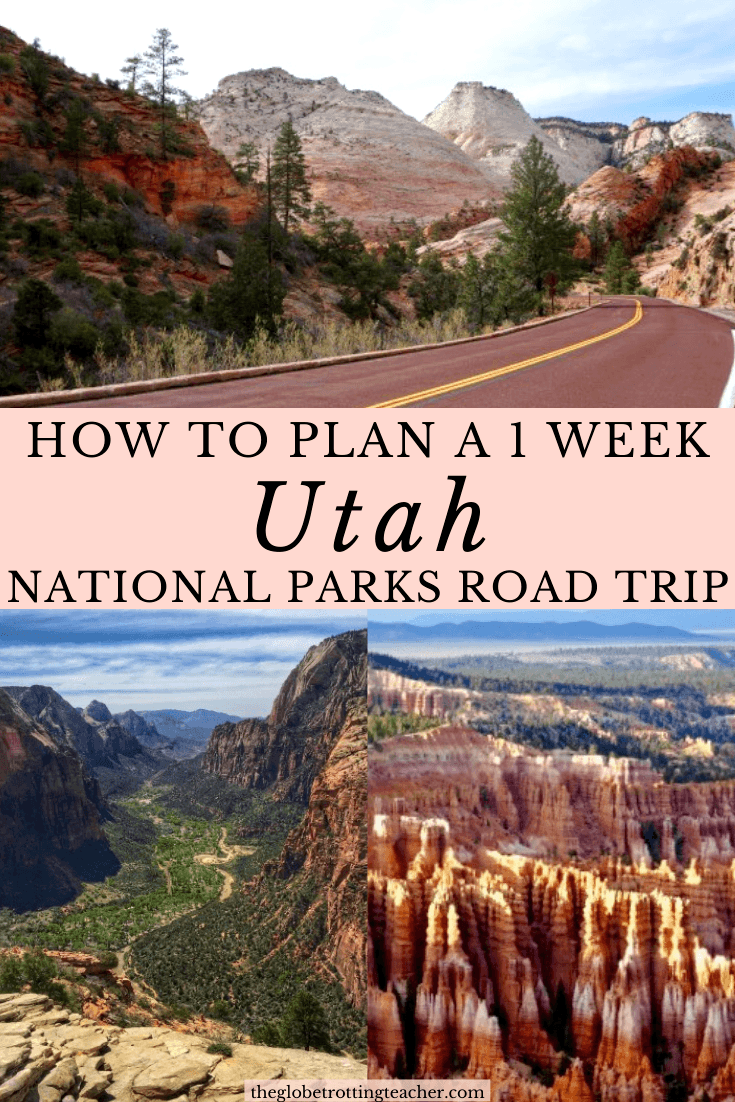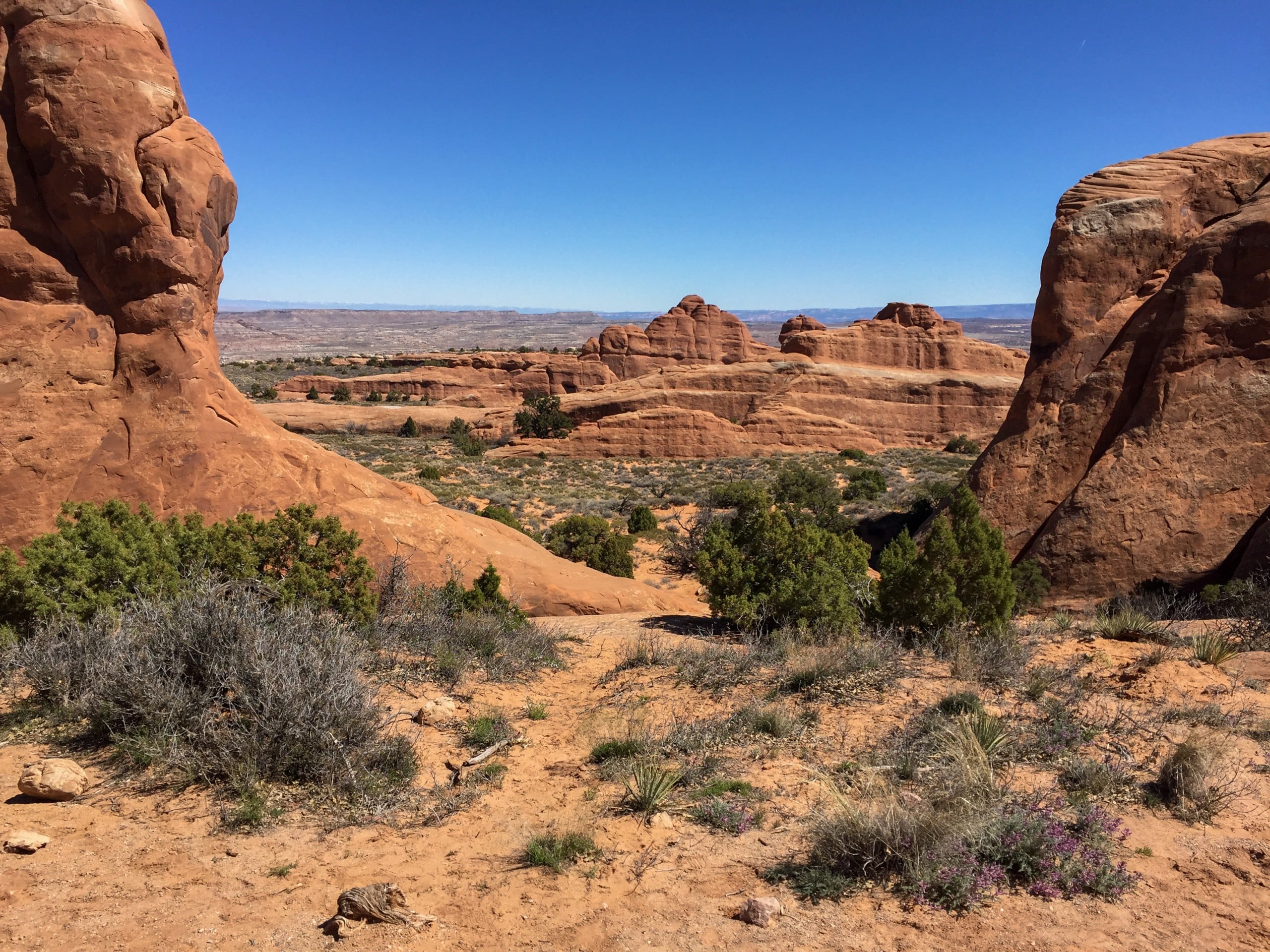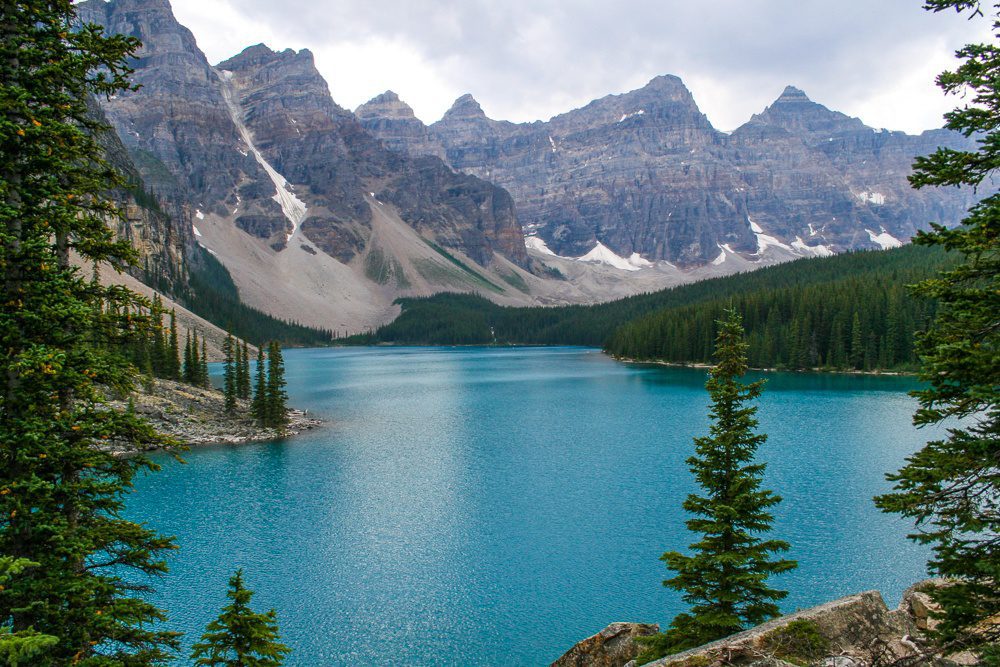Utah’s National Parks are simply stunning. And planning a Utah National Parks road trip is the best way to see and enjoy them.
From lush green valleys and sandstone formations in every shade of orange to deep canyons and expansive panoramas stretching as far as the eye can see, Utah’s National Parks will take your breath away, transport you to another planet, and inspire your inner sense of adventure all in one fell swoop.
You could spend an endless number of days exploring Utah’s National Parks and still leave hoping for a return visit. But if you’ve got a week (or even a bit longer), you can experience Utah’s unbelievable beauty on an unforgettable road trip.
In this in-depth Utah National Parks trip guide, find detailed and travel-tested itinerary planning advice and tips based on my own experiences from traveling throughout Utah and the American Southwest. This includes maps, important driving information, where to stay, and the best things to do in each National Park.
Plus, you’ll find several Utah National Park itinerary ideas so you can plan your ideal trip!
How to Plan a Utah National Parks Road Trip Itinerary
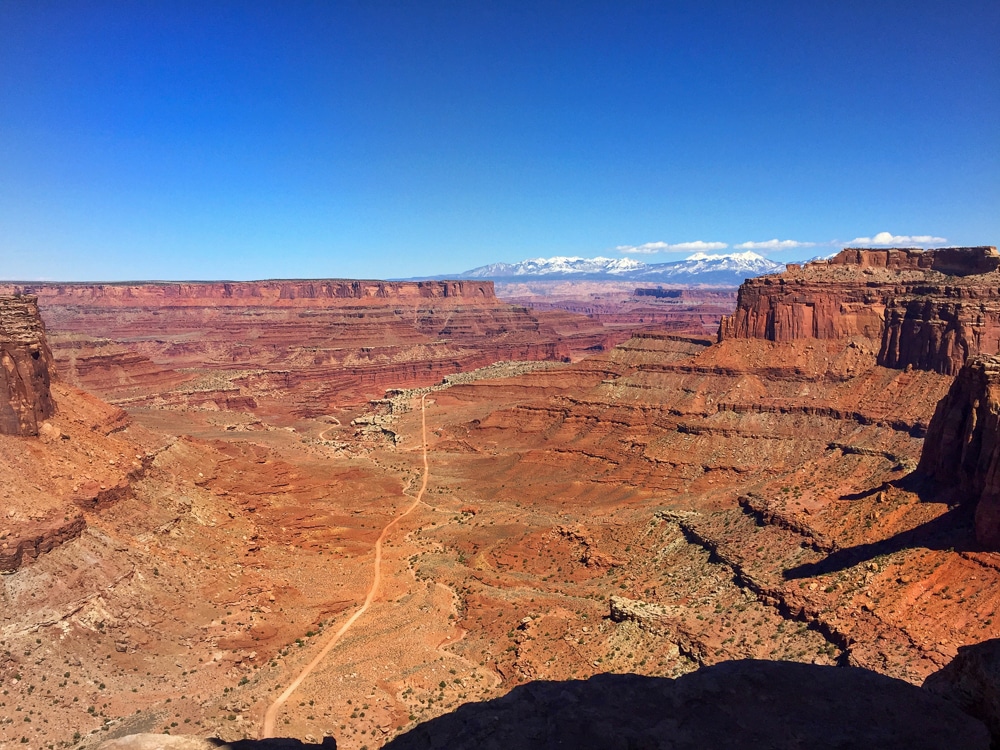
This Utah National Parks road trip guide is a true labor of love. I’ve traveled throughout Utah and the southwest, as well as to National Parks in nearby states like Colorado and Arizona. There’s no part of the United States like this corner of the country!
Quite simply, the natural beauty is jaw-dropping and the landscape offers an endless number of outdoor adventures to enjoy, from hiking and ATVing to wildlife watching and scenic drives.
Of course, the Utah National Parks steal the show, but it’s important to understand there are many State Parks and National Monuments that are equally worth seeing. If you’re like me, the problem isn’t necessarily planning a Utah road trip but having enough time to visit all the places on my list!
So, in this Utah National Parks trip guide you’ll find a few different ideas for how to plan your itinerary. Just remember, these parks are vast. If you want to do several hikes in a particular park or there are a bunch of activities that you’d like to do in a certain area, go for it!
Your Utah National Park itinerary can be about seeing Utah’s Mighty 5 or it can be about dividing your time among a couple of National Parks and the nearby State Parks and Monuments. Either way, you’ll want to return for sure! So, focus on the goal of just enjoying whatever places you add to your itinerary. You can’t go wrong!
Where to Start Your Utah National Parks Road Trip
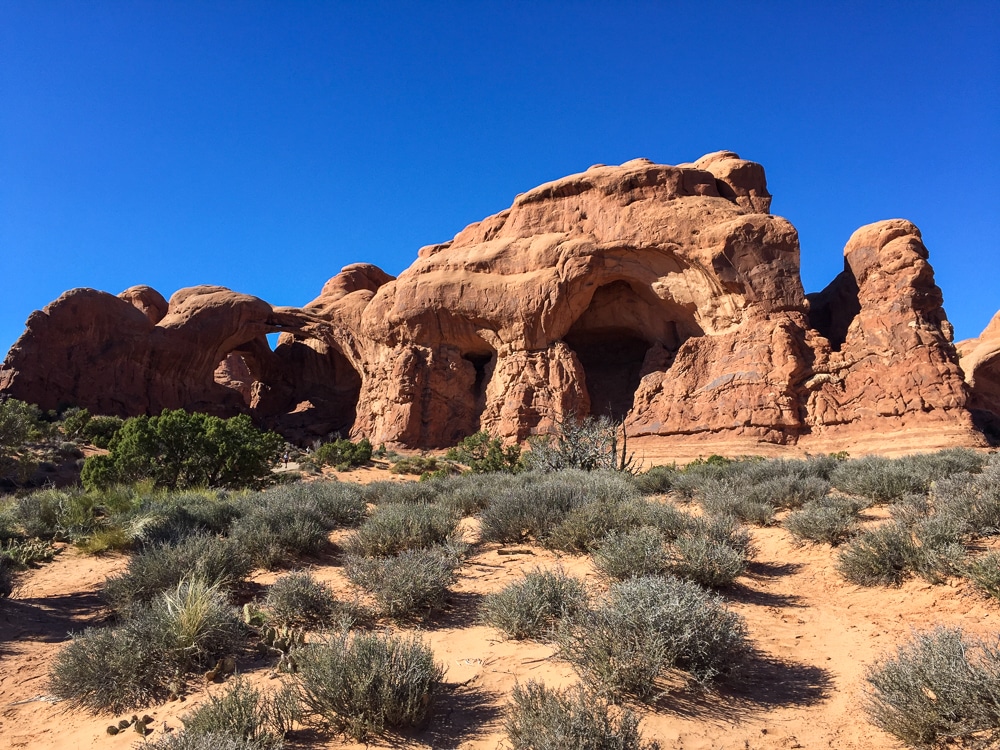
Salt Lake City and Las Vegas are the best places to start and/or end your trip to the Utah National Parks. These 2 cities have major airports with plenty of flights in and out each day. Most major U.S. airlines fly in and out of these airports but it’s good to remember that Delta has a lot of flights to and from Salt Lake City while Southwest Airlines is very active at the airport in Las Vegas.
It’s great to have both options because you can search for cheap flights with some flexibility. The same is true if you’re using miles and points to book an award flight as there may be available seats in one starting point but not the other.
I recommend flying into one of these airports and out of the other, especially if you have just 1 week for your Utah National Parks trip. Generally, airlines don’t charge more for multi-city bookings, although you should always do your homework. You likely can fly into Las Vegas and out of Salt Lake City, for example, for roughly the same price as a classic round trip.
As for rental cars and pesky one-way rental fees, they do exist. However, they’re not universal and they are applied or not according to a range of factors. So, I recommend pricing it out because you could find there is no one-way fee for your travel dates or that it’s nominal and worth saving the time driving back to your original airport.
I started my very first Utah National Parks road trip in Salt Lake City and Moab and would gladly do so again.
Renting a Car for Your Utah National Parks Road Trip
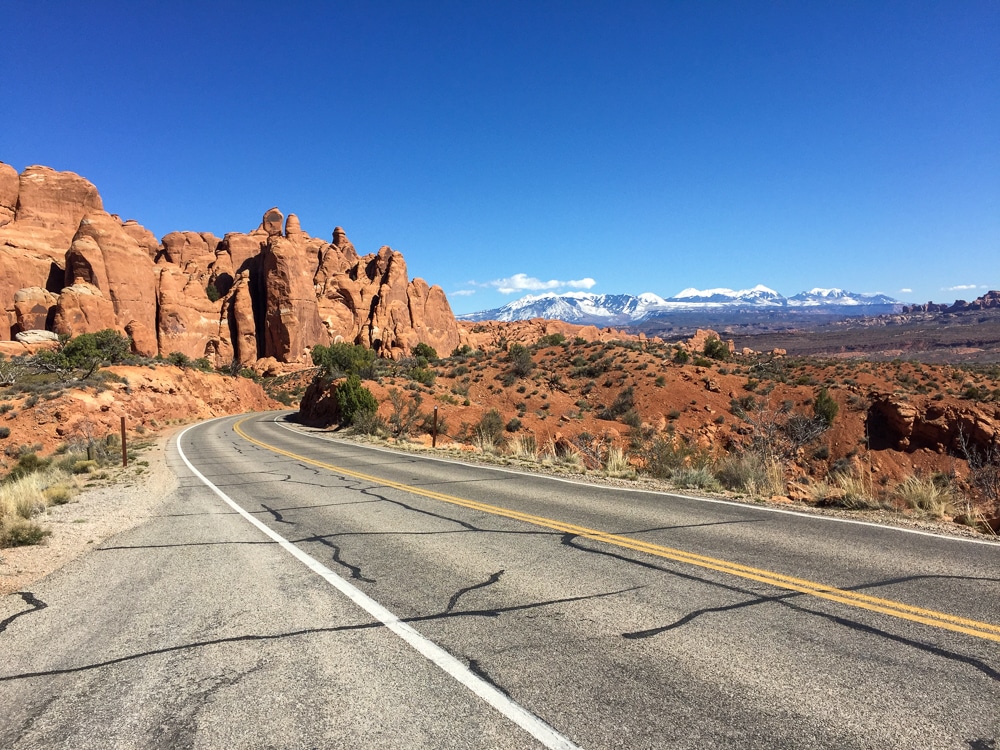
Whichever airport you fly into, you’ll need to rent a car. Both Salt Lake City and Las Vegas are major airports with plenty of car rental options.
For all my road trips, I use Kayak to search rental car costs because it compares prices on many sites all at once.
Consider the time of year of your trip. Some of the parks have steep and narrow roads. If you want to do any off-roading, definitely rent a vehicle with 4-wheel drive and preferably one with some clearance underneath. That being said, my first Utah road trip was in the spring and I rented a basic sedan-style car and had no problems.
ProTip: Unless your road trip is coming up right away and you’re renting a car last minute, never pre-pay for your rental. Instead, book a pay-at-the-counter rate and then hopefully save money with this car rental hack.
Alternatively, if you’re planning to drive to Utah from where you are, be sure your car (and everyone in it) is ready and prepared with this travel-tested road trip packing list.
How Many Days Do You Need for a Utah National Parks Trip?
Your Utah road trip should be at least 7 days. One full week gives you the chance to see all 5 Utah National Parks or a combination of National Parks and other places like Monument Valley or Grand Staircase- Escalante National Monument.
If you can spare a few more days for a 10-day itinerary for the Utah National Parks, you’ll have time to see all 5 National Parks plus make a couple of more stops to more fully take advantage of the incredible natural beauty in the area.
I would be leaving something major out by not pointing out how close you are to the Grand Canyon when you’re in southern Utah. From Grand Staircase, the Grand Canyon’s south rim entrance (and the rim with the best views) is just under 3 hours by car. From Zion National Park, it’s about a 4 1/2 hour drive.
How to Save Money on Utah National Parks Admission
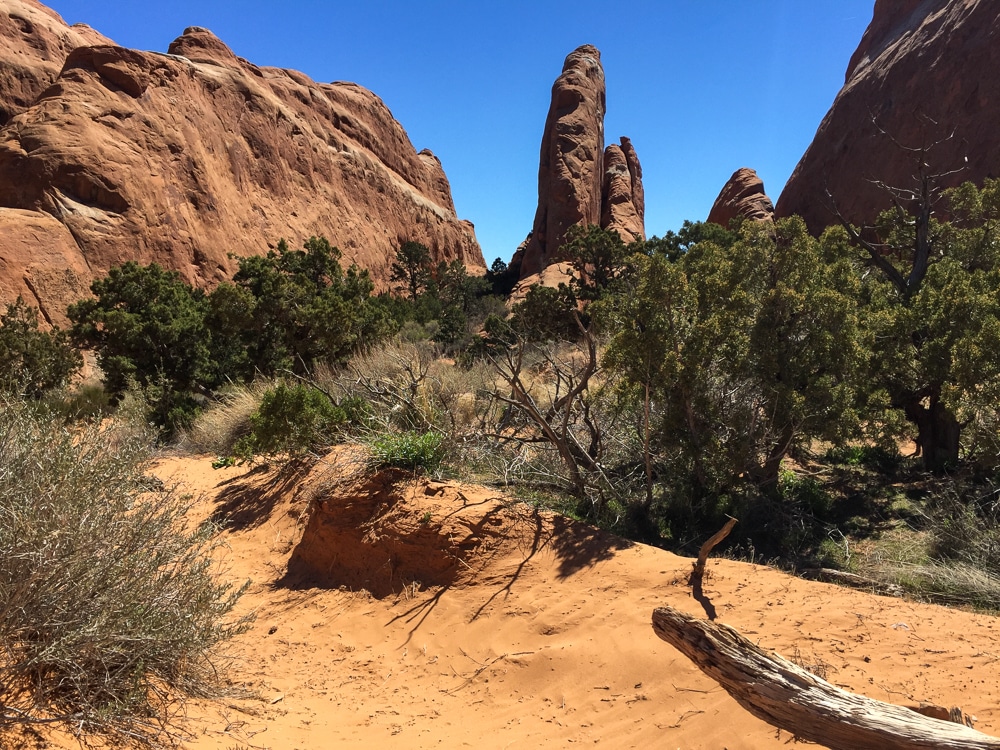
Buy the America the Beautiful Pass before your trip to get entry to any National Park for 1 year.
The pass is also valid at all places managed by the Forest Service, National Park Service, including National Monuments, the Fish and Wildlife Service, the Bureau of Land Management, the Bureau of Reclamation, and the Army Corps of Engineers.
After visiting just a few National Parks, the pass will pay for itself. Not to mention, many National Parks have separate lines for Pass holders and visitors needing to buy an entry pass. Needless to say, the lines to buy entry passes tend to move slower than those for pass holders no matter where you are.
The Pass admits a car-load of people which includes a driver and all passengers in a personal vehicle at places that charge by the vehicle. For sites that charge for each person, a total of 4 adults can enter with the pass. Kids 15 & under are free at National Parks and other related sites.
Keep in mind, the America the Beautiful Pass pays only for admission. If you need things like a campsite or an RV hookup, you’ll still need to pay the fees for these things.
Alternatively, you can find out before your trip if you qualify for another way to save money on National Park entrance fees.
1-Week Utah National Parks Road Trip Itinerary
With a 7-day itinerary for the Utah National Parks, you’ll be moving at an energetic, but totally doable, pace. You want to be efficient and maximize your time. The Utah National Parks road trip map above shows you how to do just this by limiting, or removing altogether, any backtracking between parks and streamlining where you start and end your Utah trip.
It also means arriving in Salt Lake City and departing from Las Vegas. You’ll save nearly 2 hours of driving by NOT returning to Salt Lake City to fly home. In my opinion, these hours are worth saving.
Imagine a scenario where you depart from the airport in Las Vegas at around midday. Making the drive from Zion National Park makes it possible to stay in or near the park the night before your return home to fully enjoy that day. Whereas a longer drive could mean cutting the previous day short to position yourself for your flight. Not to mention the hassle of needing a hotel near the airport for a night.
From a more dramatic standpoint, starting with the 2 National Parks in and near Moab, Arches, and Canyonlands, is an awe-inspiring start. While ending with Zion is like the magnificent grand finale of the best fireworks display you’ve ever seen.
This itinerary does not allow time for stopping at National Monuments or State Parks. Nor does it include time in Monument Valley or the Grand Canyon. You could absolutely tailor the itinerary to include 1 or more of these places but with 7 days, you’ll have to eliminate at least 1 Utah National Park.
With all that said, here’s a day-by-day look at this Utah National Parks itinerary.
Day 1- Fly into Salt Lake City –> Drive to Moab
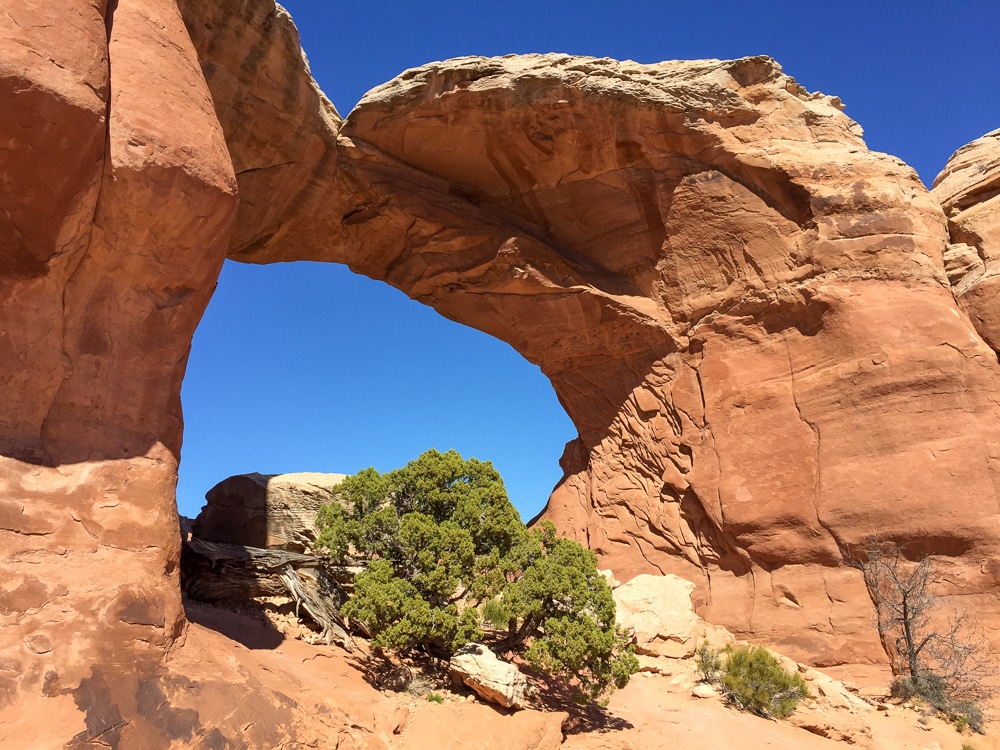
Once you’ve picked up your rental car at the airport, head southeast for just under 4 hours from Salt Lake City to Moab, Utah.
Your rental car should have a full tank of gas but, if it doesn’t, fill up at one within the first 2 hours of the drive. Likewise, stop for snacks or something to drink for the drive within this timeframe. After that, you won’t find many rest stops or exits with services until you get closer to Moab.
Once you’re in Moab, you’ll find everything you need from food to gas to lodging. If you’ve arrived with some daylight still in the sky, you’ll get your first unbelievable glimpse at the red rock landscape towering along the town’s fringes.
Use what’s left in the day to settle into your accommodations and get ready for a fresh start in the morning!
ProTip: You could also fly into Las Vegas and do this road trip in reverse, as mentioned above. It’s part of the beauty of this road trip route compared to others I’ve taken like this Oregon Coast road trip itinerary that must be done from north to south.
Where to Stay in Moab:
Of all the times I stayed in Moab, I enjoyed staying at the Hyatt Place Moab the best. It’s on the main road through town, close to 2 National Parks, and comes with a free breakfast. Perfect when you’re planning a day of hiking and outdoor fun!
If you’re a miles and points enthusiast like me, it’s also one of several loyalty program hotels in Moab. You can use Hyatt points to book the Hyatt Place.
Whichever Moab hotel you choose, book it for 2 nights.
Day 2- Arches National Park
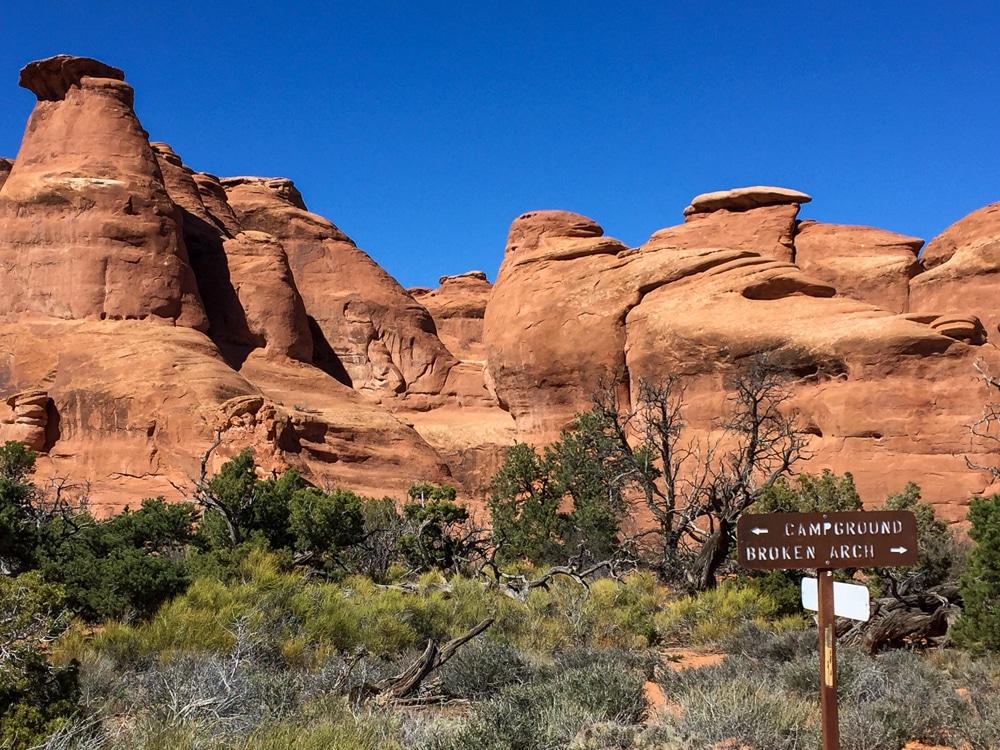
If you arrived in Moab after dark, prepare yourself! The morning light reveals the orange and red rock formations surrounding the city. What’s more, it’s just a glimpse of the stunning red rock landscape and sandstone arches that await in the National Park.
Before heading to the park, pack water and lunch/snacks for the day. Moab has plenty of places to stock up. Arches heats up even in the spring and fall. The rocky desert landscape has no cover from the sun and only a couple of spots to drink from a water fountain. You want to enter the park prepared.
Be on time and arrive at Arches National Park for your timed entry slot. Luckily, the National Park is just 5-10 minutes from downtown Moab so it’s easy to reach from Moab’s main road.
Arches National Park Highlights
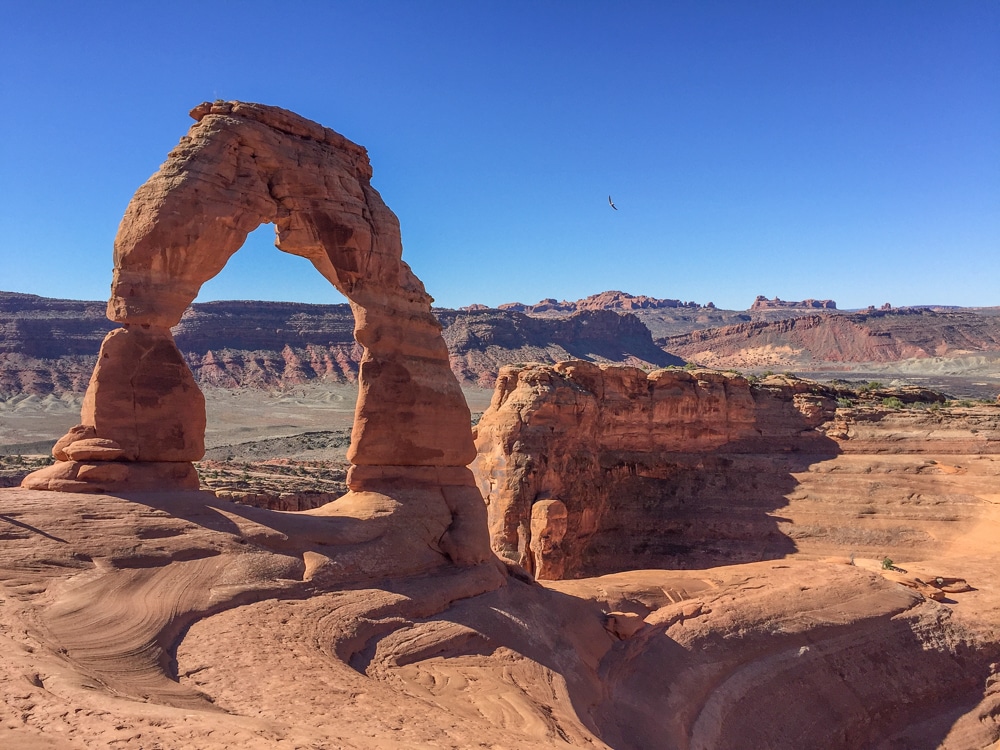
Arches National Park is appropriately named for its 2,000+ arches! Combined with balancing rocks, ridges, slopes, and towering rock faces, the park absolutely dazzles. One gorgeous vista is replaced by the next whether you’re driving along the park’s main road or hiking one of the many trails.
The park has so many things to do, it’s not possible to hike every trail in 1 day. But, with a morning start, it’s possible to see a lot and hike some of Arches’ most famous trails.
Don’t miss these top things to do in Arches National Park.
Moab Travel Tips
For a detailed Arches National Park guide, check out:
How to Plan 1 Awesome Day at Arches National Park
Day 3- Canyonlands National Park –>Head to Capitol Reef Area
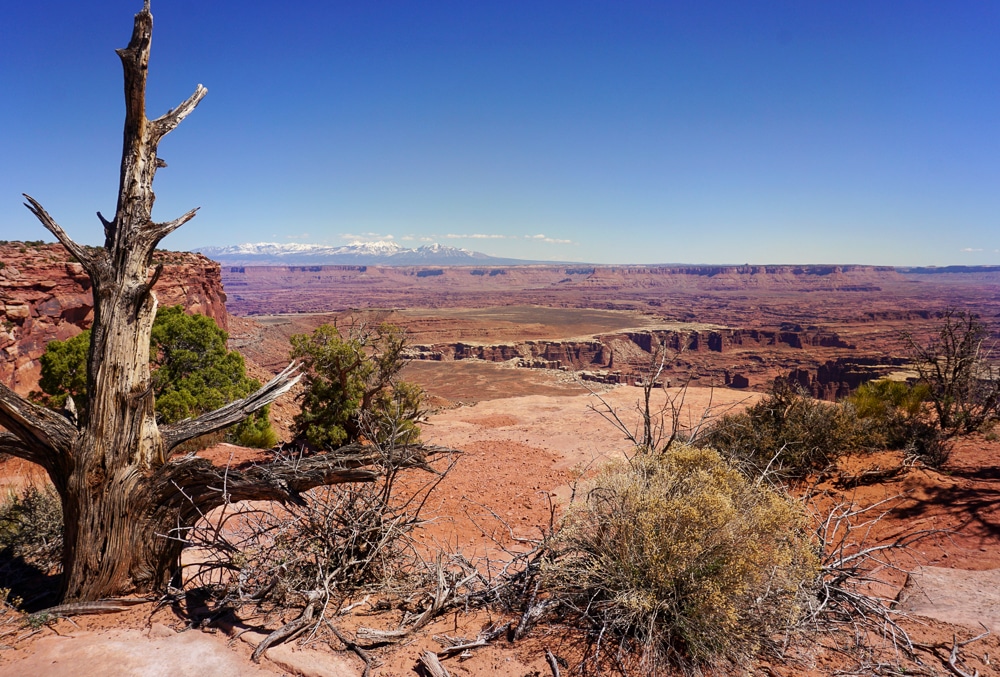
This morning, you’ll check out of your hotel in Moab and drive to Canyonlands National Park. It’s less than an hour from Moab, leaving you a good amount of time to enjoy a day in the park.
Before leaving town, gas up and make sure you have anything you need for lunch, snacks, and drinks so you’re set for the day because you won’t find service at Canyonlands other than a water station at the visitor’s center.
Canyonlands National Park is divided into 3 land districts. The Island in the Sky section of the park is by far the most visited area and the one you’ll be heading to today. I’ve also spent time in this part of the park. The Maze and Needles Districts are more rugged and better suited for backcountry pursuits and those who are experienced in that type of terrain.
Just before reaching Canyonlands entrance and visitor’s center, take a detour into Dead Horse Point State Park. The lookout at Dead Horse Point Overlook is a must-see!
After this brief stop, return to the main road and on to the entrance of Canyonlands National Park.
Canyonlands National Park Highlights
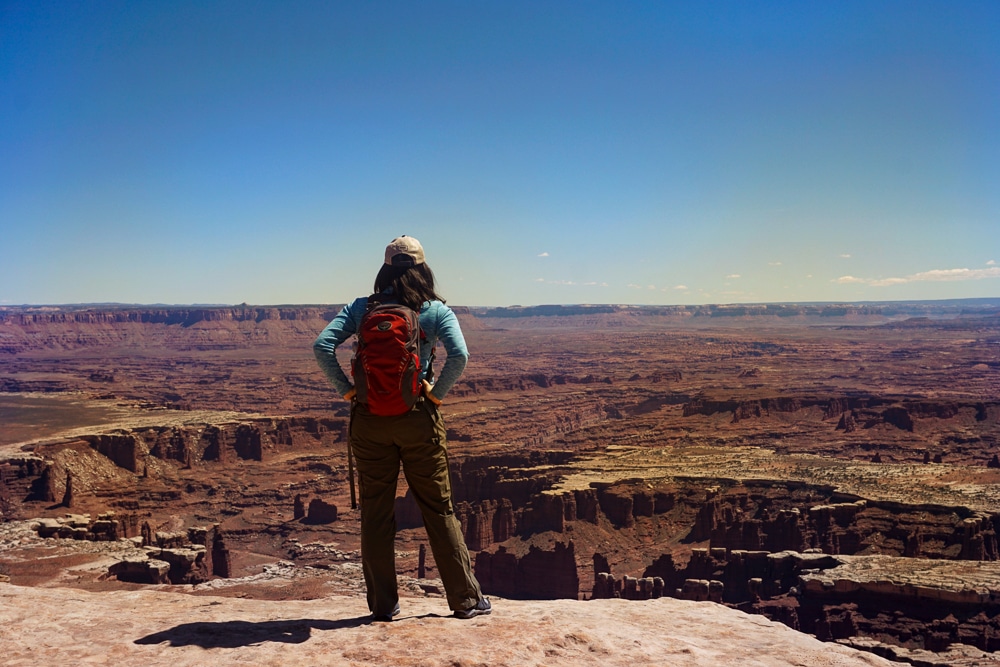
Canyonlands sits in the high desert. Its canyons, arches, mesas, and rock formations were painstakingly shaped by water, gravity, and the elements over millions of years. Compared to Arches National Park, Canyonlands is much more rugged and wild.
Whereas arches like Delicate Arch or Double Arch look as if they were shaped by the hand of a skilled sculptor, the rock formations and desert landscape at Canyonlands has a harsher, rougher feel.
Canyonlands Island in the Sky District can be visited and enjoyed in 1 day. The park has some of the best off-roading anywhere and numerous challenging hikes but fortunately those of us who stay on top of the Island in the Sky mesa don’t miss out on anything.
Aside from hikes or short walks, Canyonlands has one beautiful scenic overlook after another. No need to rush. Simply enjoy your time in the park today.
Here are some of the best things to do at Canyonlands National Park.
Canyonlands also has off-roading but you need to have the right vehicle and potentially a permit as is the case with White Rim Road. But if you’re looking for a thrill and you have an SUV or a vehicle with high clearance, you could take a drive below the rim of the mesa along Shafer Canyon Road. It’ll take a couple of hours and doesn’t require a permit.
Canyonlands Travel Tips
For a guide about 1 Day at Canyonlands, check out:
How to Spend an Inspiring Day at Canyonlands National Park
Where to Stay Tonight:
By late afternoon, say goodbye to Canyonlands and begin the drive to the Capitol Reef National Park area. The drive is just under 3 hours. The park’s visitor center is in the tiny town of Torrey.
There, you’ll find hotels and places to have some dinner before calling it a (fantastic) day.
I recommend the Skyridge Inn because the rooms are cozy and a hearty breakfast is included in your stay. And sitting just 7 miles from the Capitol Reef, you’ll get to the park easily in the morning. Not to mention, the property views are gorgeous!
Torrey has accommodation options for all budgets so compare hotel prices to see which matches your budget.
Where to Stay Tonight Alternative- Monument Valley
As you plan your Utah National Parks road trip, it’s hard to decide what to see and do especially if you have just 7 days. This area of southern Utah and into northern Arizona is jam-packed with incredible sights.
I’ve followed the route above going to each of Utah’s “Mighty 5” National Parks and I’ve also gone from Canyonlands to Monument Valley. The drive is just 3 hours and 15 minutes to Monument Valley and brings you to one of the most iconic natural landmarks in the entire United States.
If you’d rather see Monument Valley, it’s an easy switch. Instead of driving from Canyonlands to Capitol Reef, head south on Route 191 to Monument Valley. (Be sure to have a full tank of gas and snacks as rest stops are far and few between.)
When you arrive in Monument Valley, you’ll have only a couple of hotel options. I highly recommend The View Hotel in the Navajo Nation or the Goulding’s Lodge just 2 minutes away. These hotels are directly in Monument Valley so it’s very convenient for exploring Monument Valley the next morning.
Plan to stay 1 night at either hotel. You can compare prices and availability here.
ProTip: On the way from Canyonlands to Monument Valley, stop to see Mexican Hat Rock and Forrest Gump Point if you have the time. They’re both along the way and don’t require a detour. If it’s already late, you see them tomorrow.
Day 4- Capitol Reef National Park –>Drive to Bryce Canyon
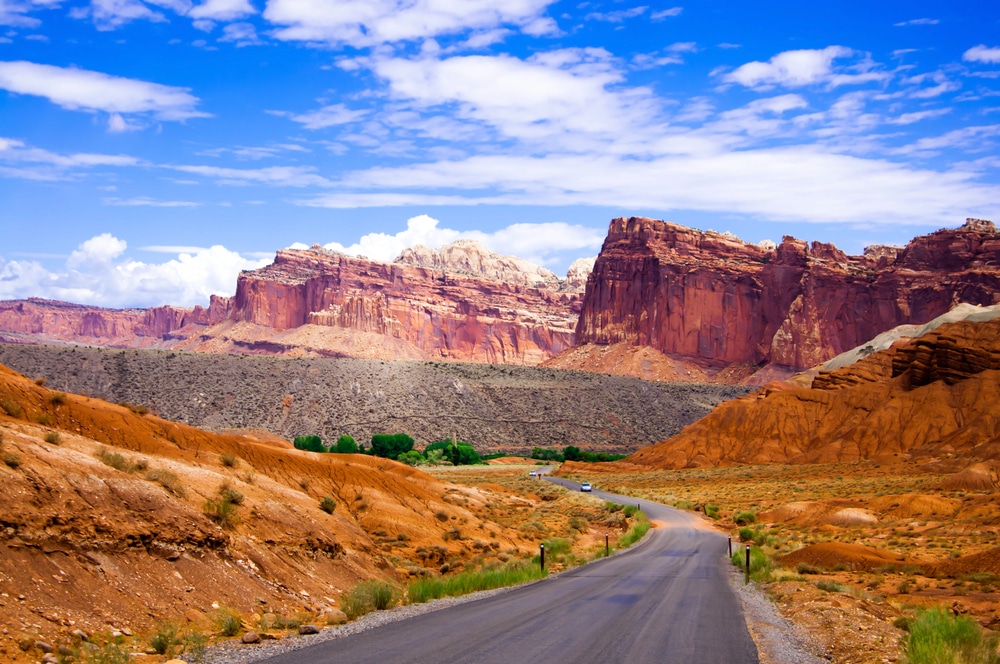
Capitol Reef sits along a “wrinkle” in the Earth’s crust. Officially, it’s called a monocline which is a waterpocket fold and in this case, runs for 100 miles. The National Park itself is 60 miles long but only 6 miles wide
When the fault lines in the Earth shifted millions of years ago, the sides weren’t equally lifted. In Capitol Reef’s case, the crust on the west side ended up higher than on the east side. As a result, water sits in the fold and wears away the layers of rock and things like domes, canyons, and even fossils come to light.
It’s hard to imagine how all of this geology happens. But it’s actually when you visit Capitol Reef and try to put this scientific knowledge in context as you stare at the gorgeous landscape in front of you.
For me, it was even more mind-blowing to realize that a canyon, dome, or arch was only in plain sight because of the layers that had been worn away all because of the uneven shifting in the Earth’s crust!
Capitol Reef Highlights
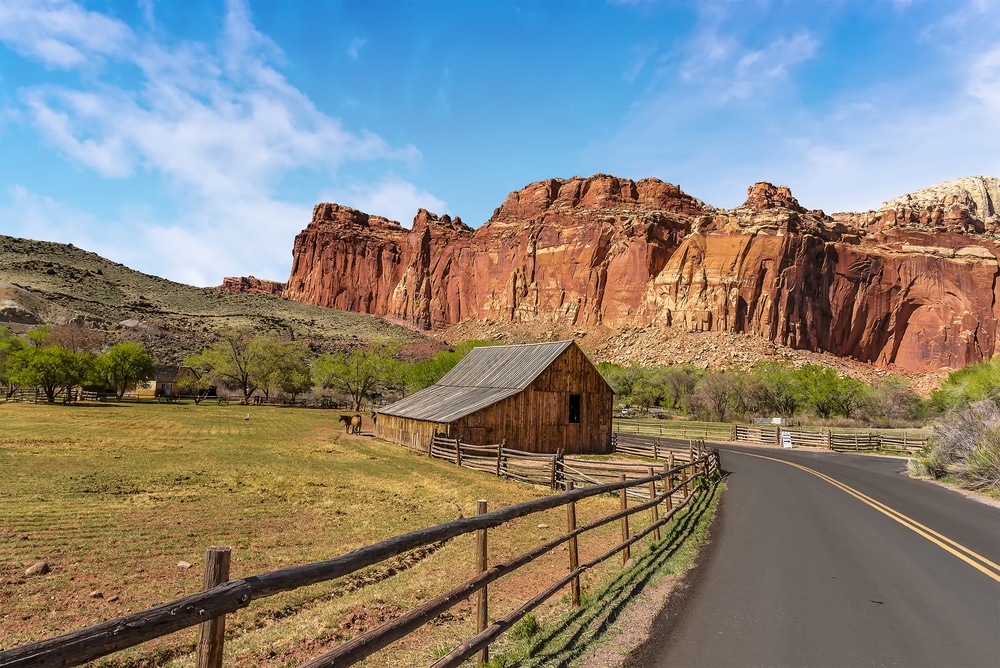
Capitol Reef has fantastic hikes and scenic landscapes as you drive along the part of the park along Highway 24. The rock formations together with the desert panorama create some of the most striking views among Utah’s Mighty 5. And in many areas of the park, you’ll find trails that feel light years away from the crowds at Arches National Park.
The main part of Capitol Reef also has a historic settlement called the Fruita District. It was here where the first Mormon pioneer settlers came. In 1 day or part of a day, you can see some of these natural and historic highlights.
Here are some of the best things to do at Capitol Reef.
Capitol Reef Travel Tips
Day 4 Alternative- Monument Valley –> Drive to Bryce Canyon
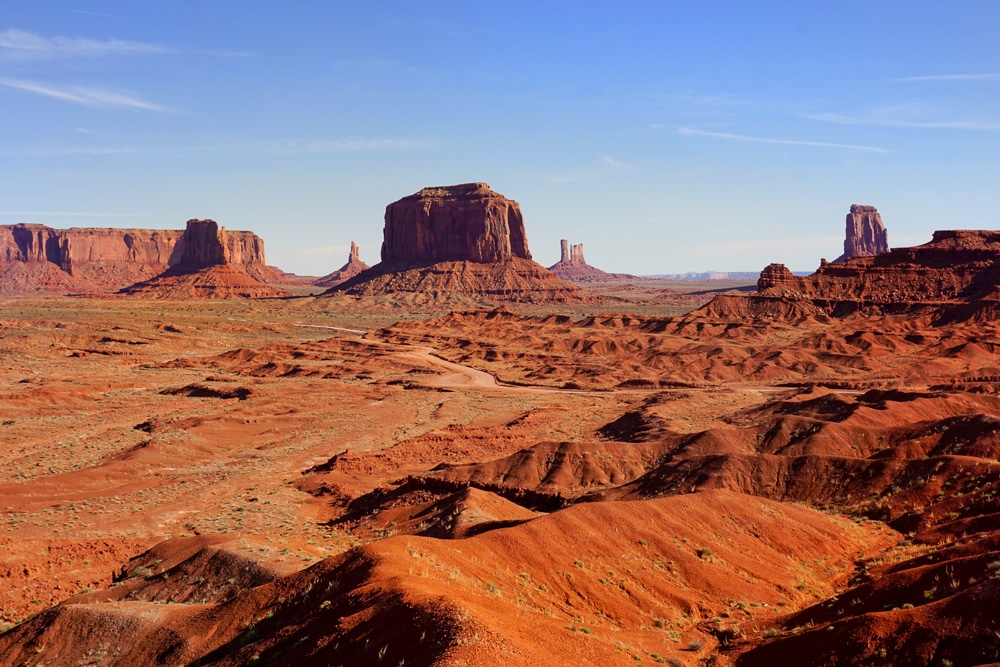
Tumbleweed blows across the open valley. Iconic sandstone monuments dot the landscape. You’ll feel as if you’ve stepped into a scene from an old Western with a bunch of cowboys chasing down a group of thieves! (Or perhaps you’d like to take your perfect Forrest Gump shot.)
The most popular mesas, buttes, and spires are along a 17-mile loop within the Monument Valley Navajo Tribal Park. You can join a guided tour or drive yourself.
I drove my small rental car with no problem. Yes, the road is rough and bumpy, but if you drive slowly and carefully, you’ll be fine. Choosing the self-driving option also allowed me to enjoy the views at my own pace.
However, the upside to a tour with a Navajo guide is you can access more of the tribal park. Some areas are closed to visitors and can only be visited with a guide. Plus, you’ll get more context of what the rock formations in Monument Valley symbolize in the Navajo culture.
Here are the best things to do in Monument Valley.
For a detailed Monument Valley Guide, check out:
Everything You Need to Know for an Epic Visit to Monument Valley
Where to Stay Tonight- Bryce Canyon
ProTip: Your hotel in Bryce Canyon should be among the first things you book for your Utah National Park road trip. There are only a few hotel options in Bryce. Once they sell out, there aren’t really any other options in the immediate surrounding area.
No matter what you choose to do for Day 4 of your Utah National Park itinerary, you’ll stay the night in Bryce Canyon to position yourself for tomorrow’s visit.
If you’re driving from Capitol Reef, the drive is straightforward. You can comfortably enjoy the day at the National Park and later in the afternoon start the drive to Bryce.
If you’re driving from Monument Valley, you’ll be heading west and then north to Bryce. Along the way, look out for Page, Arizona, home to the famous Horseshoe Bend.
If you can manage a quick stop, you’ll have gotten a bonus and checked off a fantastic spot that’s a must for every Arizona road trip. Plus, it comes at about the halfway point in the drive, so it’s a perfect time to stretch your legs and find bathrooms. A short hike (1.4 miles round trip on a flat, paved path) at Horseshoe Bend leads to the popular scenic overlook.
Afterward, continue to your hotel in Bryce Canyon. Depending on what time it gets dark when you visit, you may even make it to Bryce Canyon to see the hoodoos lit up at sunset.
Bryce is a tiny town right at the edge of the National Park entrance. I stayed at the Best Western Plus Ruby’s Inn and had a comfortable stay. I’ve also looked at the Best Western Plus Bryce Canyon Grand just across the street but the availability didn’t fit what I needed.
Whichever you choose, book a room for 1 night.
Day 5- Bryce Canyon National Park –> Zion National Park
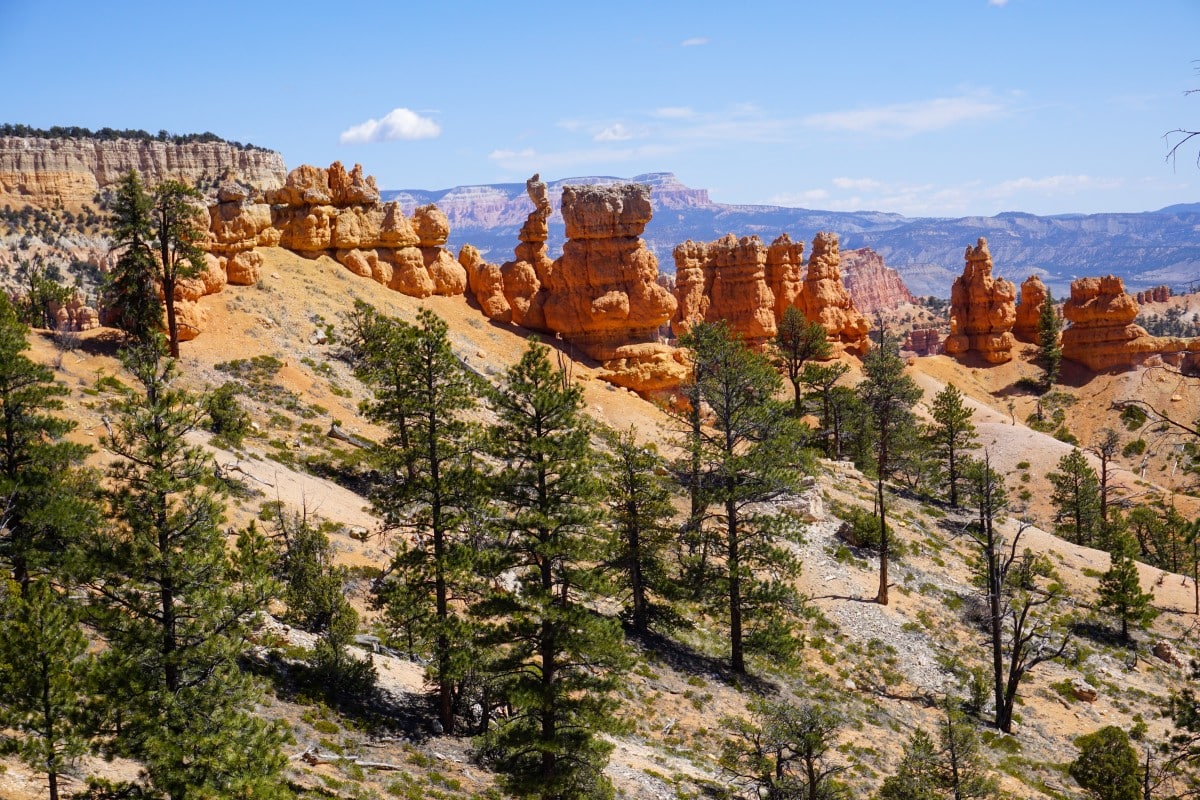
Bryce Canyon National Park is like descending into a fairytale land where sandstone hoodoos stare up at you from a natural amphitheater and show off their brilliant shades of orange, pink, and red.
If you’ve never heard of a hoodoo before, it’s the geological name for irregular columns of rock. And Bryce Canyon has more hoodoos grouped together than any other place on the planet.
No matter how many National Parks you’ve visited, once you visit Bryce you’ll understand what I mean when I say, this National Park is like no other. Bryce Canyon and its hoodoo amphitheater are beyond impressive!
Bryce Canyon Highlights
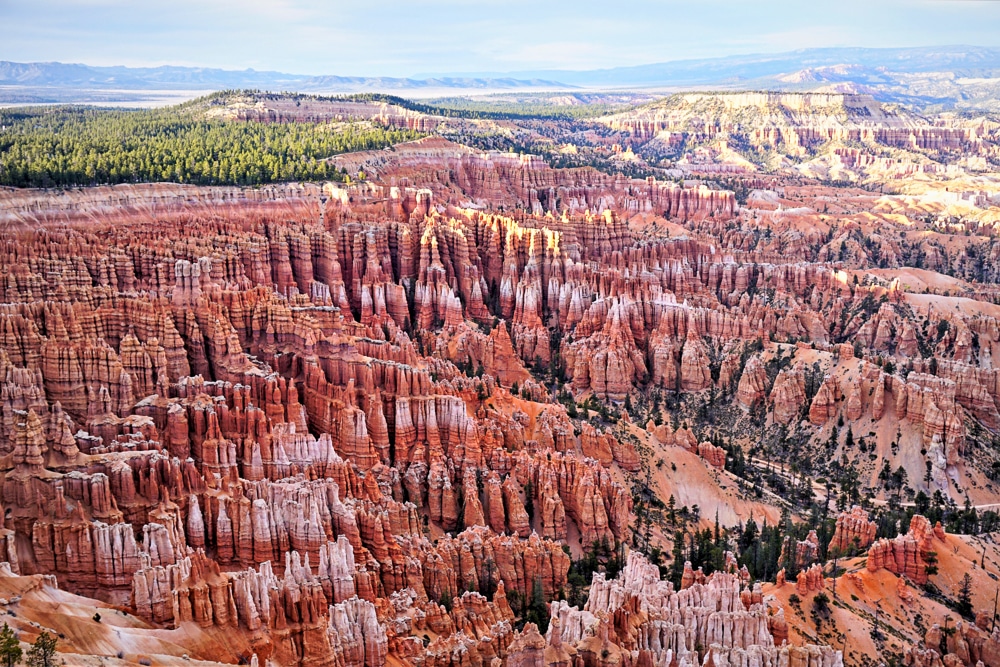
The National Park’s main road sits up on a plateau and runs for 18 miles from north to south with the Hoodoo amphitheater visible from a series of viewpoints and overlooks. Some of these pull-offs and parking areas also have trailheads. Some hiking trails wind along the rim of the canyon. Others lead down into the canyon.
The best part of this layout is that everyone can enjoy the jaw-dropping beauty of Bryce Canyon, either by hopping from overlook to overlook in a car, hiking along the park’s trails, or a combination of both.
Depending on how early you start your day and how much (if any) hiking you’re planning in Bryce Canyon, you can spend half a day here or more. Even with 1 of the hikes below, you still have plenty of time to see the amphitheater from several viewpoints and leave by early afternoon.
That being said, you can also spend the full day in Bryce Canyon National Park. There are plenty of trails and photography opportunities to enjoy.
I would also factor in whether your trip to the Utah National Parks ends on Day 7 or you can fly home on Day 8. Ultimately, you want to make sure you have enough time for magnificent Zion National Park.
Here are the best things to do in Bryce Canyon National Park.
Bryce Canyon Travel Tips
For more Bryce Canyon Inspiration and Tips, check out this guide.
25 Photos to Make You Want to Visit Bryce Canyon National Park
Where to Stay Tonight- Springdale, Zion National Park
Make your way from Bryce Canyon to Springdale Utah. Be sure to use the Mount Carmel Highway and Tunnel to enter Zion and the town. It’s an engineering marvel but the views before and after the tunnel are incredible.
Springdale, Utah is the park’s gateway town. You’ll find everything you need from lodging and food to tour and gear shops. Not to mention, it’s a cute little town that has everything you’d want after a day spent in the National Park.
I highly recommend the Holiday Inn Express in Springdale. Not only was it the nicest Holiday Inn Express I’ve stayed in, it had a pool, free breakfast, and the free town shuttle bus to Zion stopped just outside.
Outside of the winter months, cars aren’t allowed to drive into Zion. Instead, visitors take the Zion’s shuttles to enter and move around the park. The town shuttle bus outside the Holiday Inn Express brings you to these Zion shuttles which is a logistical life-saver. There’s absolutely nowhere to park near Zion’s entrance so it’s smarter to keep your car parked at the hotel and make use of the shuttles.
The town shuttle makes stops along the main road through Springdale. You can compare prices at hotels along this road to find the best option for your travel dates.
Days 6 & 7- Zion National Park
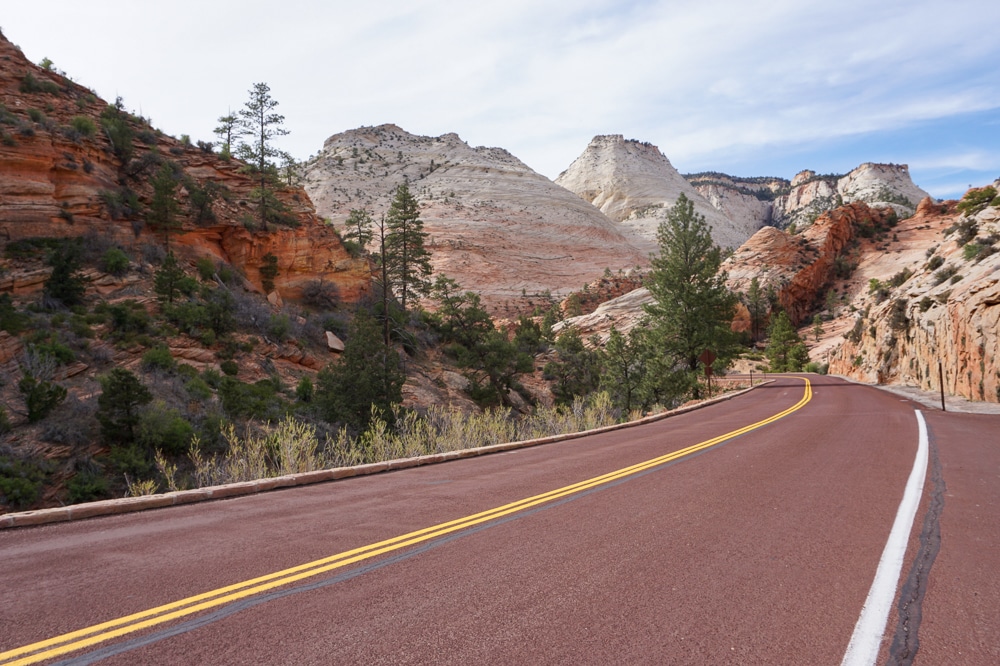
Zion National Park grabs you by the senses and overwhelms you with its magnificence. You’ll understand how special Zion truly is from the moment you drive along the Mount Carmel Scenic Highway with its towering mountains on all sides.
Despite all the red rock landscapes you’ve seen up to this point on your Utah National Parks road trip, Zion will leave you in awe. The towering walls of rock with the Virgin River flowing and the greenery complementing the backdrop combine for absolute natural perfection.
Zion Canyon was shaped over millions of years. The landscape that we see today is home to all different types of plants and animals. I saw more animals in Zion than at any other Utah National Park, including lots of babies on my spring visit! So when you’re driving the Mount Carmel Scenic Highway or out on the hiking trail be mindful and respectful.
Zion National Park Highlights
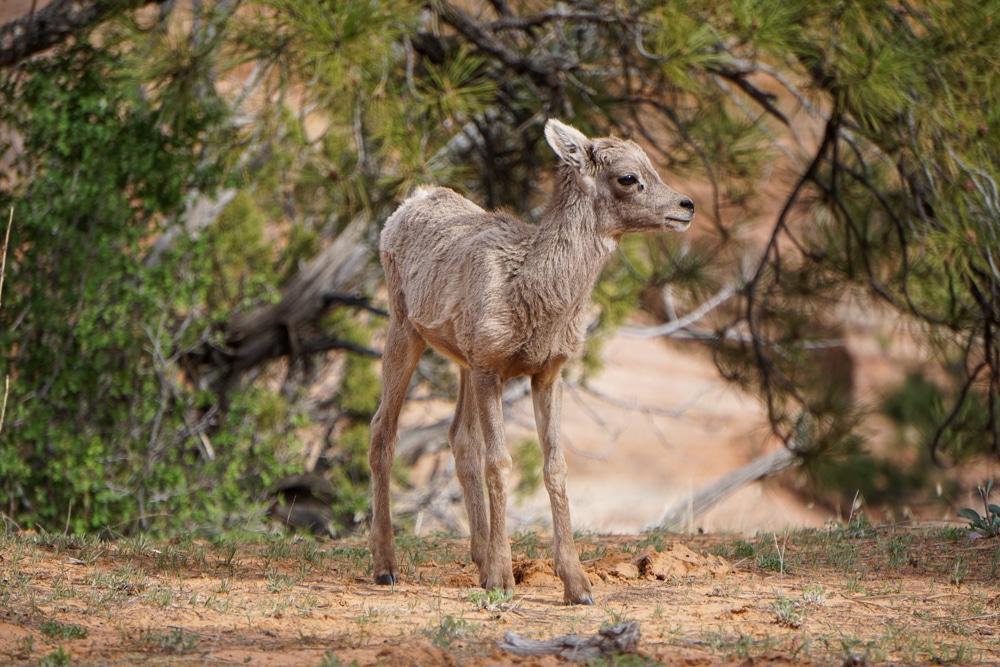
Zion offers an endless number of activities for every type of adventurer across its 230 square miles of outdoor heaven. Hike, horseback ride, mountain climb, and spot wildlife to your heart’s content. There are also guided excursions into Zion’s slot canyons and The Narrows.
Zion National Park’s most famous hike is to Angels Landing. This strenuous and steep hike takes you to the lookout over Zion Canyon. As mentioned above, you must get a permit for Angels Landing as the park works to limit the number of people on the narrow and rocky climb to the top. Apply for a permit as soon as you’re able to get the date and time you want.
If you’re physically fit and not afraid of heights, I highly recommend giving Angels a try! It’s a tough climb and you absolutely have to be careful. But, the view and the accomplishment are worthwhile rewards.
To enter the park, catch the Zion National Park Shuttle from the entrance in Springdale to different points within the park. Shuttles run continuously to pick up and drop off park visitors at popular sights and trails throughout the park.
Here are the best things to do in Zion National Park.
Zion National Park Travel Tips
For a complete Zion National Park guide, check out:
What You Need to Know for a Successful Zion National Park Visit
8 Spectacular Things to Do at Zion National Park
Climbing Angels Landing Hike at Zion National Park
Day 7-8 Zion National Park –> Las Vegas Airport
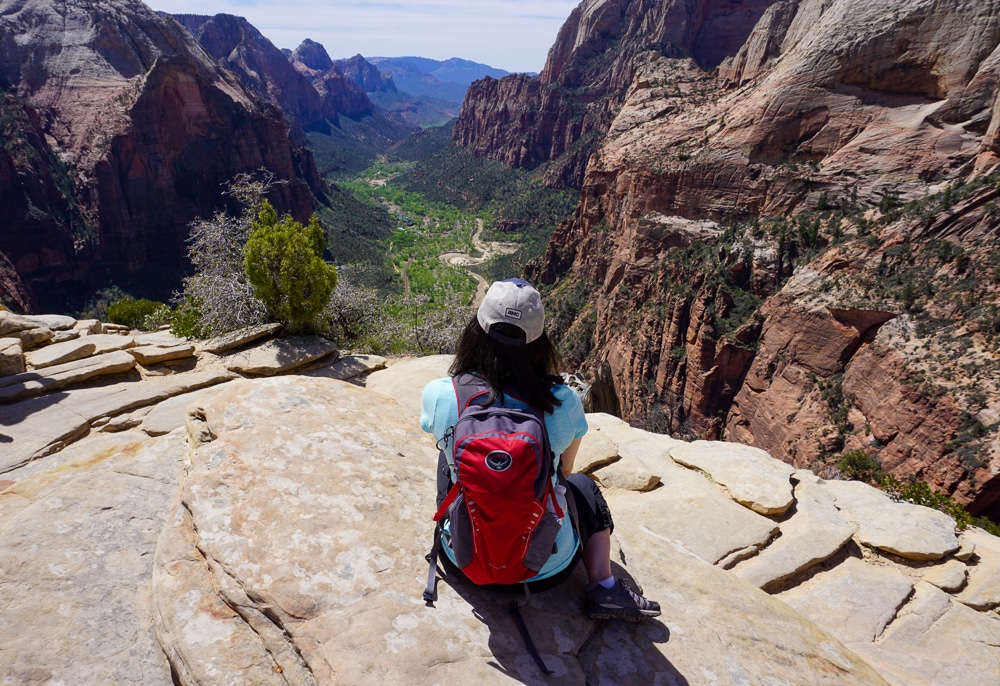
If you’re like me sitting on top of Angels Landing at the end of my time in Zion, you won’t want to leave! But unfortunately, it’s time to check out of your hotel in Springdale and end your Utah road trip.
Depending on when you need to fly home, you could plan to depart on the evening of Day 7 so that you can still possibly have a couple of morning hours in Zion before heading to the airport.
If you can, head home on the morning of Day 8 so you can enjoy all of Day 7 at Zion.
Tearfully, say goodbye to Zion and make the 2.5-hour drive to Las Vegas. Plan to return your rental car at the airport. Then, head for home with unforgettable memories from your fantastic Utah National Parks road trip!
Planning a longer Utah National Parks Trip?
Lucky you! There’s so much more to see and do at each National Park than what you’ll be able to cover with just the week itinerary above. And the area around the National Parks in Utah and Arizona has so many iconic natural icons.
So while you could simply plan to spend more time in one or more of the above National Parks, you could also look to expand on your Utah itinerary. The ideas below give you an idea of how to do this.
More Ideas to Plan Your Road Trip to Utah & Beyond
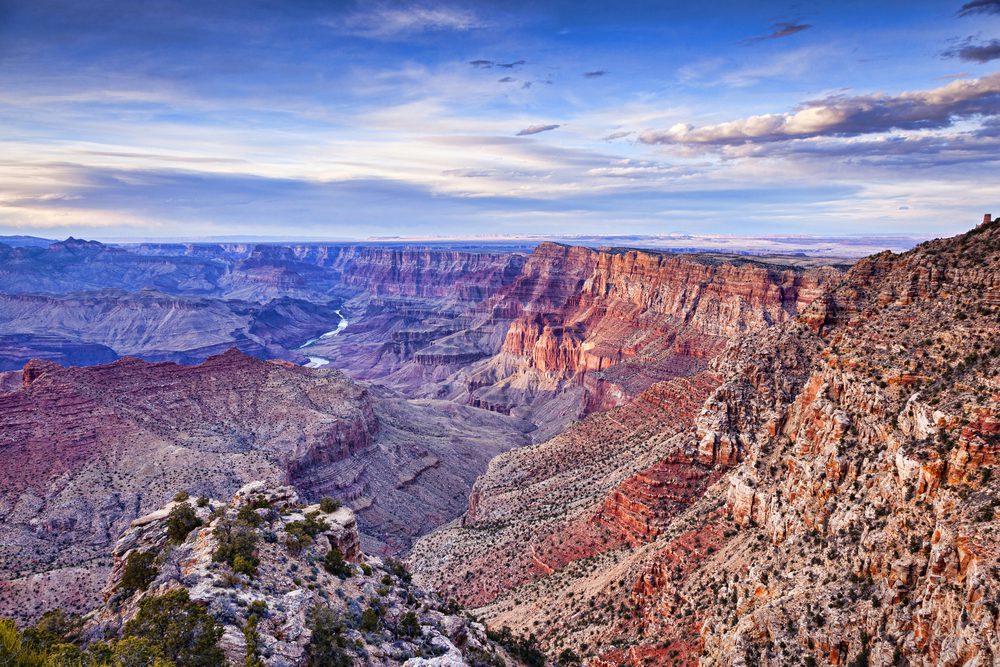
Plenty of visitors add a few days to their trip to see Flagstaff and the Grand Canyon. You could include these places along with Monument Valley and/or Zion National Park, and more Utah National Parks depending on how much time you have.
Antelope Canyon is a natural wonder between Monument Valley and Bryce and Zion National Parks. Why not plan extra time in the area to take a guided tour? You could also visit Horseshoe Bend!
Arizona and Utah are great road trip partners! Why not do part of an Arizona road trip along with seeing some of Utah’s National Parks? You could even head south towards Tempe and Tuscon.
Spend 1-2 days in Las Vegas. After a week of outdoor fun in Utah’s National Parks, a posh Las Vegas hotel, fine food, and some nightlife might be the perfect way to end your vacation.
Looking to do an extended road trip out west? You could easily start with a Colorado road trip and then cross the border to reach Moab to begin your Utah road trip itinerary. You could fly into Denver and out of Salt Lake City, for example, while seeing National Parks like Rocky Mountain, Black Canyon of the Gunnison, Mesa Verde, Canyonlands, and Arches plus Monument Valley.
When is the Best Time to Do a Utah National Parks Road Trip?
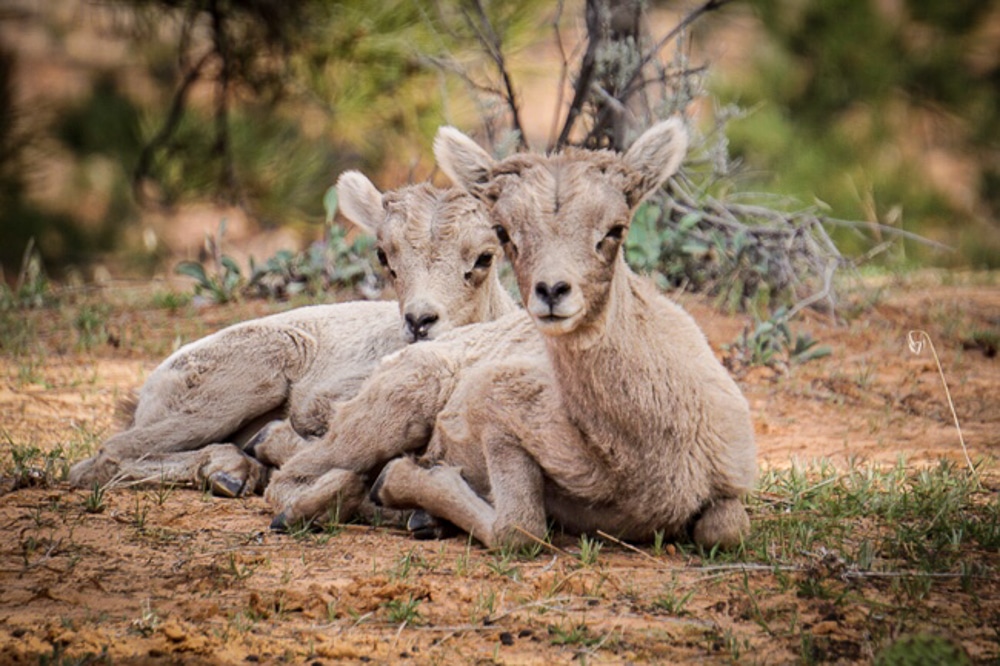
Spring and Fall are the best times to do a Utah National Park road trip. The temperatures are more pleasant and most snow (in spring) will be melted, clearing the way for hikers and park visitors to once again use most trails.
That being said, you should try your best to plan a spring or fall Utah trip outside of school holiday weeks, long weekends, and free National Park Days. The parks have large crowds around this time. And with higher demand comes higher prices for everything from flights to hotels to rental cars.
Also, keep in mind that spring snowmelt can create elevated water levels and stronger currents and rivers and streams. So popular hikes like The Narrows in Zion National Park could be closed if the conditions are unsafe.
What about Visiting the Utah National Parks in the Summer?
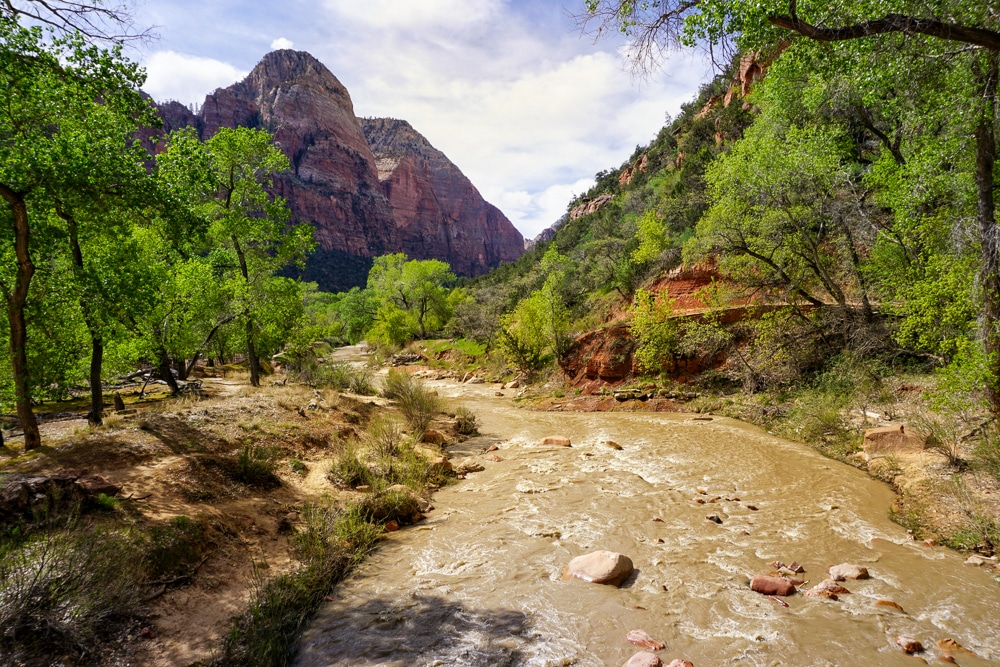
Both of these seasons have their pros and cons. But I’ll cut right to the point and say that given the choice, I’d visit in winter over summer. Here’s why.
The summer months come with extremely high temperatures like 95+ degrees. This doesn’t factor in the real feel temperature that comes from the strong sun exposure. Because of the terrain, most areas of the Utah National Parks get full sun with few areas to find shade. This can make the midday hours unbearable for hiking and other outdoor activities.
Summers are also quite busy given that families take vacations while students are off from school. As mentioned above, Arches National Park requires a timed-entry reservation to help manage the number of visitors.
What about Visiting the Utah National Parks in Winter?
On the other hand, winters come with no crowds and don’t require reservations. You’ll feel like you have the parks to yourself! Less demand also means it’s a much more affordable time to visit. You’ll find the best prices for hotels, especially, during the winter.
Of course, the truth that we can’t overlook is the temperatures that hover from the 30s-50s in December, January, and February. Snow is possible, although days tend to be sunny and dry. More likely, you’ll see a possible lighter dusting of snow in higher elevations while much of the red rock terrain and iconic arches are just as beautiful as any other time of year.
The one exception here is Zion, which tends to be wet during the winter. This could lead to snow or ice accumulating on the trails, forcing the park to close them until they are safe again.
I’d much rather layer up and hike on cooler sunny days. With the right hiking clothes and a combination of body heat, the temperatures are more ideal than those in summer.
If you decide to visit Utah’s Mighty 5 in winter, check the conditions in each park before your visit to know, too, if any roads or trails are closed because of snow or ice.
Is It Possible to Do 2 National Parks in 1 Day?
While it might be logistically possible, like with Arches and Canyonlands or Zion and Bryce, because of their proximity to each other. However, I would not recommend this at all.
Not only would you miss seeing and doing many things in each National Park, but you’d also likely feel very rushed and quite unsatisfied. At this pace, you’d never get a feel for any place you were in or truly be able to enjoy the beauty of a National Parks road trip…to be outdoors and connect with nature.
Utah National Parks Road Trip Bottom Line
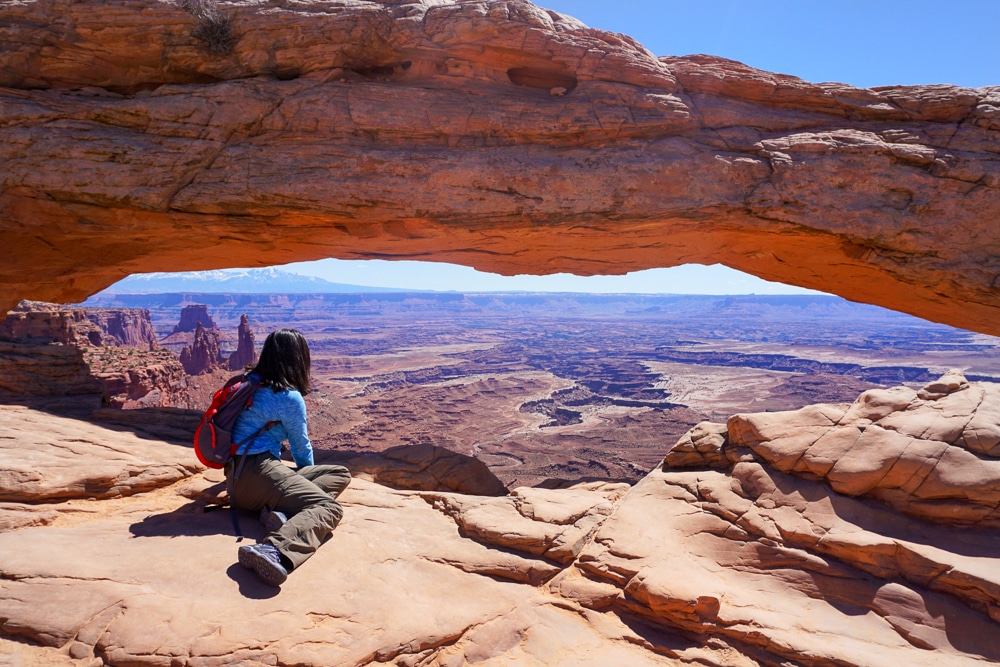
Planning a Utah trip is an absolute bucket list experience! You get to see and enjoy some of the most iconic National Parks, natural places, landmarks, and monuments in the United States.
Whether you have a week, 10 days, or more, there is an endless number of Utah itineraries that you can plan. Having traveled extensively through this part of the country, I can assure you that you can’t go wrong no matter what your Utah road trip looks like! So, let’s get planning!
What are you planning to see and do on your Utah National Parks road trip itinerary?
Like this post? Please share it on social media using the share buttons below.
